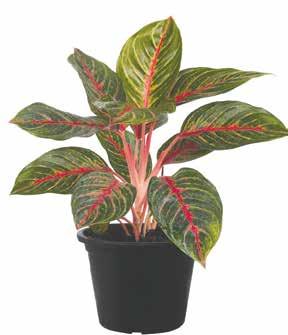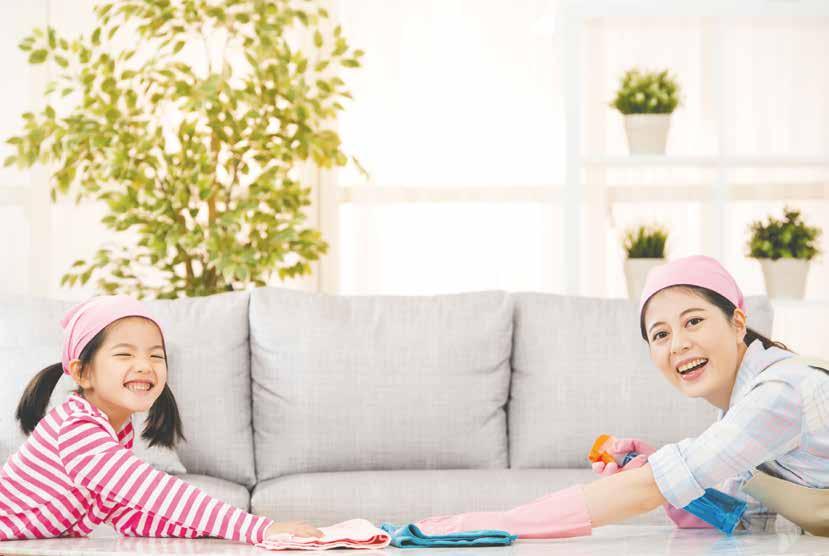
5 minute read
HEALTHY HOME
How to Detoxify a Living Space
by Yvette Hammett
Advertisement
tatiana/Pexels.com A s the world moves into its second year of a viral pandemic, many of us are still spending most of our time at home—working, exercising, hanging out with family and as with any other year, cooking and cleaning. There’s no better time to take stock of these surroundings and purge them of any toxins—gases, inhalants or fumes—that may be contributing to a harmful environment.
Start with the air. Research shows that indoor air is two to five times more toxic than the air outside, due to inadequate ventilation. This condition, coupled with fumes from synthetic fibers, makeup, paints, cleansers or even a baby’s plastic toys, can contribute to health issues and a less environmentally beneficial abode. A straightforward solution—in addition to getting rid of the pollution-causing objects—is to open the windows and use fans to recirculate the air. A high-efficiency particulate air (HEPA) filter can safely remove many contaminants, but don’t spritz a commercial air freshener: A University of Washington study found that eight widely used air fresheners released an average of 18 chemicals into the air, some of them hazardous, including the likely human carcinogen acetaldehyde.
Purge plastics. Perfluorinated compounds PFAS and PFOS, known as “forever chemicals”, are found in nonstick cookware, water-repellent clothing, stain-resistant fabrics and carpets, some cosmetics, and products that resist grease, water and oil. They have been found to cause a wide range of health problems from kidney and testicular cancers to endocrine disruptions. Consider doing a clean sweep of the house to determine which of these can be replaced, paying special attention to plastics. “If you really limit plastics to a few things, you are fine,” says Heather Patisaul, Ph.D., a neuroscience and toxicology expert at North Carolina State University.
Reconsider kitchenware. Eliminate all nonstick cookware, Patisaul advises. “Use ceramic and other materials that do not have perfluorinated chemicals.”
Debbie Steinbock, a nutrition counselor at Mindful Family Medical, in Boulder, Colorado, suggests replacing plastic storage containers, which can leach chemicals when heated. “Use a cast iron skillet and use glass jars and mason jars for food storage.”
Chuck out toxic cleaners. Many commercial kitchen, bathroom and other cleaning products are loaded with chemicals linked to asthma, cancer, reproductive disorders, hormone disruption
and neurotoxicity. They can be particularly toxic for children: A recent Canadian study found that repeated use of a disinfectant reduced beneficial gut bacteria in toddlers, probably contributing to obesity. A good place to start in cleaning out the cleaners is at the Environmental Working Group (EWG) website ewg.org; its Healthy Living Home Guide evaluates the health risks of 2,500 cleaning products. It also advises a simple strategy of using vinegar and water or baking soda.
Get the lead out. Andrew Rooney, deputy director at the National Toxicology Program of the National Institute of Environmental Health Sciences, sees lead, which causes brain damage and other serious defects, as a major risk present in water supplies and the paint of older homes. “The thing I want to emphasize is there is no safe level of lead exposure, so eliminating exposure sources is the best protection for your health,” he says.
Drinking water contamination comes from the distribution lines and plumbing fixtures, with lead leaching out from repairs or adjustments. “Having your household water tested by a certified lab is the best option to determine if you have water issues,” he says. Consult state and local health agencies for guidance on lead paint or lead in the water lines and how to remove it. Also consider a water filter: ConsumerReports.com has a comprehensive rating of models from pitchers to under-sink setups.
Take it a step further. The new EWG downloadable Healthy Living app makes it easy to use a smartphone to check out 120,000 products for toxic ingredients, including cosmetics and foods. “It has a barcode scanner to scan your favorite lipstick or shampoo, and it will pop up an ingredient list and give it a score,” says Patisaul. The database includes ingredients not found on packaging and scores products on a zero to 10 scale. “It pretty much has to be water to get a zero,” she says.

Yvette Hammett is an environmental writer based in Valrico, Florida. She can be contacted at YvetteHammettHull49@gmail.com. 1Improve air quality in the home by removing carbon dioxide and toxins such as benzene 6Indoor plants psychologically link us to nature, adding to our sense of well-being
2Reduce formaldehyde in the air by up to 90 percent
3Stimulate physical and psychological relaxation responses
4Increase ambient humidity in the home by as much as 10 percent
5Increase microbial activity in the home, which stimulates the immune system 7Being around plants makes us feel more comfortable, productive and creative
8Houseplants help boost energy and reduce fatigue
9Having a houseplant nearby lowers blood pressure and reduces stress
10Pets will also enjoy better air quality and better health
Top Plants for Air Quality
Sansevieria (mother-in-law’s tongue,
snake plant) — super-low maintenance, grows in low light and is pet friendly
Pothos — also makes an excellent hanging basket (toxic to dogs and cats)
English ivy — another great hang-up plant (toxic to dogs and cats)
Bamboo palm — prefers bright light, but will grow in low light and it’s pet-safe
Dracaena (mass cane, corn plant) — needs bright, indirect light; this tall, upright plant is great for spaces to add height (toxic to dogs and cats) very low light. It’s mildly toxic to both pets and people.
Chinese evergreen (Aglaonema) — A wide, large-leafed plant that offers a variety of variegated foliage colors. Performs best in medium light conditions. Must be kept evenly moist to avoid losing its leaves. Toxic to dogs and cats.
A tip o’ the hat to Marshall Grain, located at 3525 William D. Tate Ave., in Grapevine. For more information, call 817-416-6600 or visit MarshallGrain.com.
Rubber tree plant — like its relative, Ficus benjamina, the rubber tree (Ficus elastica) is a bit finicky, needing just the right amount of light and water. Both varieties are toxic to dogs and cats.
Peperomia — Pet-friendly, it resembles an African violet with succulent leaves and stems. It needs bright but indirect light to maintain it’s vibrant foliage.
African violet — Keep the plant evenly moist and always water from the bottom. Pet-friendly.
ZZ Plant (Zamioculcas) — Virtually indestructible, the ZZ plant will grow in






